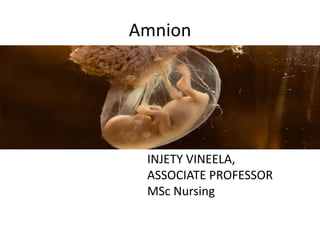
Amniotic cavity.pptx
- 2. • Fully formed amnion or amniotic membrane is 0.02-0.05mm in thickness. • The layers are : • Single layer of cuboidal epithelium • Basement membranes • Compact layer of reticular structure • Fibroblastic layer and • Spongy layer The amnion has got neither blood nor nerve supply nor any lymphatic system.
- 4. origin • The precise origin of the liquor amnii is still not well understood. • It is probably mixed maternal and fetal origin. Circulation: the water in the amniotic fluid is completely changed and replaced every 3 hours. The presence of lanugo and epithelial cells in the meconium shows that the fluid is swallowed by the fetus.
- 5. Volume • Amniotic fluid volume is related to gestational age. • It measures about 50ml at 12 weeks, 400ml at 20 weeks and 1000ml at 36-38 weeks. • Thereafter the amount diminishes by 200ml at 43 weeks.
- 6. Physical features • The fluid is faintly alkaline with low specific gravity of 0.010. • It becomes highly hypotonic to maternal serum at term pregnancy. Color: in early pregnancy it is colorless, but near term it becomes pale straw coloured due to the presence of exfoliated lanugo and epidermal cells from the fetal skin. It may look turbid due to the presence of vernix caseosa.
- 8. Composition • Water(98-99%) • Solids(1-2%) • The followings are the solid constituents: • Organic and inorganic.
- 9. Organic • Protein-0.3mg% • Glucose-20 • Urea-30 • Uric acid-4 • Total lipids-50 • Hormones • Creatinine-2
- 10. Inorganic • The concentration of sodium chloride and potassium is almost the same as that found in maternal blood. • As pregnancy advances there maybe slight fall in the sodium and chloride concentration probably due to dilution by hypotonic fetal urine, where as potassium concentration remains unaltered.
- 11. Suspended Particles • Lanugo, exfoliated squamous epithelial cells, vernix caseosa, cast of amniotic cells, cells from respiratory tract, urinary bladder and vagina.
- 12. Functions • During pregnancy • During labor
- 13. During Pregnancy • It acts as a shock absorber-protecting the fetus from possible extra uterine injuries. • Maintains even temperature • The fluid distends the amniotic sac and thereby, allows the growth and free movement of the fetus and prevent adhesion between fetal parts and amniotic sac. • Water supply to fetus • Nutritive value is negligible.
- 14. During Labor • Helps in cervical dilatation • Protects placenta and fetus as long as membranes remain intact. • Guards from umbilical cord compression • Flushes birth canal at the end of first stage of labor. • This provides aseptic and bactericidal action protects of the fetus and prevents ascending infection to uterus.
- 16. • Study of the amniotic fluid provides useful information about the fetal well being and also maturity of the fetus. • Excess or less volume of liquor amnii is assessed by amniotic fluid index. • With ultrasound, the assessment is performed. • Maternal abdomen is divided into 4 quadrants. • Taking the umbilicus, symphysis pubis and fundus as the reference points. • The largest vertical point is measured, the sum of 4 measurements is AFI IN centimeters. • Normal AFI 8-18cm.
- 17. Abnormal color • Green-meconium stained liquor • Golden colour-Rh-incompatability, lysis of RBC • Greenish yellow(saffron)-post maturity • Dark coloured-accidental hemorrhage • Dark brown(Tobacco juice)-Intrauterine deaths presence of old HB
